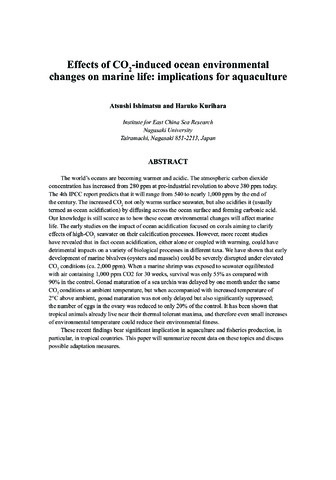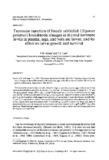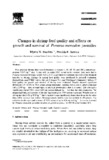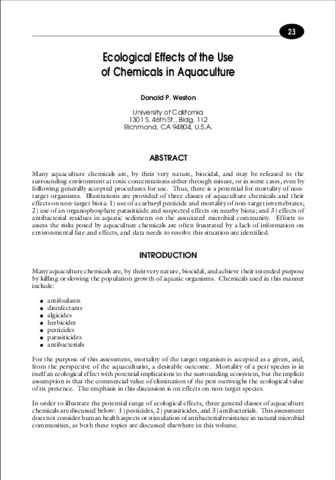Effects of CO2-induced ocean environmental changes on marine life: implications for aquaculture
Share
Abstract
The world's oceans are becoming warmer and acidic. The atmospheric carbon dioxide concentration has increased from 280 ppm at pre-industrial revolution to above 380 ppm today. The 4th IPCC report predicts that it will range from 540 to nearly 1,000 ppm by the end of the century. The increased CO2 not only warms surface seawater, but also acidifies it (usually termed as ocean acidification) by diffusing across the ocean surface and forming carbonic acid. Our knowledge is still scarce as to how these ocean environmental changes will affect marine life. The early studies on the impact of ocean acidification focused on corals aiming to clarify effects of high-CO2 seawater on their calcification processes. However, more recent studies have revealed that in fact ocean acidification, either alone or coupled with warming, could have detrimental impacts on a variety of biological processes in different taxa. We have shown that early development of marine bivalves (oysters and mussels) could be severely disrupted under elevated CO2 conditions (ca. 2,000 ppm). When a marine shrimp was exposed to seawater equilibrated with air containing 1,000 ppm CO2 for 30 weeks, survival was only 55% as compared with 90% in the control. Gonad maturation of a sea urchin was delayed by one month under the same CO2 conditions at ambient temperature, but when accompanied with increased temperature of 2 degree C above ambient, gonad maturation was not only delayed but also significantly suppressed; the number of eggs in the ovary was reduced to only 20% of the control. It has been shown that tropical animals already live near their thermal tolerant maxima, and therefore even small increases of environmental temperature could reduce their environmental fitness. These recent findings bear significant implication in aquaculture and fisheries production, in particular, in tropical countries. This paper will summarize recent data on these topics and discuss possible adaptation measures.
Suggested Citation
Ishimatsu, A., & Kurihara, H. (2011). Effects of CO2-induced ocean environmental changes on marine life: implications for aquaculture. In B. O. Acosta, R. M. Coloso, E. G. T. de Jesus-Ayson, & J. D. Toledo (Eds.), Sustainable aquaculture development for food security in Southeast Asia towards 2020. Proceedings of the Regional Technical Consultation on Sustainable Aquaculture Development in Southeast Asia Towards 2020 (pp. 35-44). Tigbauan, Iloilo, Philippines: SEAFDEC Aquaculture Department.
Subject
abiotic factors  ; acidification
; acidification  ; adaptation
; adaptation  ; growth
; growth  ; aquaculture
; aquaculture  ; calcification
; calcification  ; carbon dioxide
; carbon dioxide  ; climate change
; climate change  ; corals
; corals  ; data processing
; data processing  ; Environmental changes; Environmental effects; fisheries
; Environmental changes; Environmental effects; fisheries  ; global warming
; global warming  ; gonads
; gonads  ; larval stage
; larval stage  ; marine environment
; marine environment  ; Oceans
; Oceans  ; ovaries
; ovaries  ; survival
; survival  ; temperature effects
; temperature effects  ; water temperature
; water temperature  ; carbonic acid
; carbonic acid  ; ph effects
; ph effects  ; corals; development; Echinoidea; Penaeidae; Eastern Pacific
; corals; development; Echinoidea; Penaeidae; Eastern Pacific
 ; acidification
; acidification  ; adaptation
; adaptation  ; growth
; growth  ; aquaculture
; aquaculture  ; calcification
; calcification  ; carbon dioxide
; carbon dioxide  ; climate change
; climate change  ; corals
; corals  ; data processing
; data processing  ; Environmental changes; Environmental effects; fisheries
; Environmental changes; Environmental effects; fisheries  ; global warming
; global warming  ; gonads
; gonads  ; larval stage
; larval stage  ; marine environment
; marine environment  ; Oceans
; Oceans  ; ovaries
; ovaries  ; survival
; survival  ; temperature effects
; temperature effects  ; water temperature
; water temperature  ; carbonic acid
; carbonic acid  ; ph effects
; ph effects  ; corals; development; Echinoidea; Penaeidae; Eastern Pacific
; corals; development; Echinoidea; Penaeidae; Eastern Pacific
Related items
Showing items related by title, author, creator and subject.
-
Thyroxine injection of female rabbitfish (Siganus guttatus) broodstock: changes in thyroid hormone levels in plasma, eggs, and yolk-sac larvae, and its effect on larval growth and survival
Ayson, Felix G.; Lam, Tom J. (Elsevier, 1993)The thyroid hormone levels in female rabbitfish, Siganus guttatus, plasma, eggs, and yolk-sac larvae were measured before and after thyroxine (T4) injection in female spawners at doses of 1, 10, and 100 μg ... -
Changes in shrimp feed quality and effects on growth and survival of Penaeus monodon juveniles
Bautista, Myrna N.; Subosa, Precilla F. (Elsevier, 1997)Five practical shrimp diets were formulated to contain 1, 10, 20, 50, and 100 g tetraethoxypropane (TEP) kg−1 diet. A diet with no added TEP served as the control. Diets were fed to Penaeus monodon (average ... -
Ecological effects of the use of chemicals in aquaculture
Weston, Donald P. (Aquaculture Department, Southeast Asian Fisheries Development Center, 2000)Many aquaculture chemicals are, by their very nature, biocidal, and may be released to the surrounding environment at toxic concentrations either through misuse, or in some cases, even by following generally accepted ...




